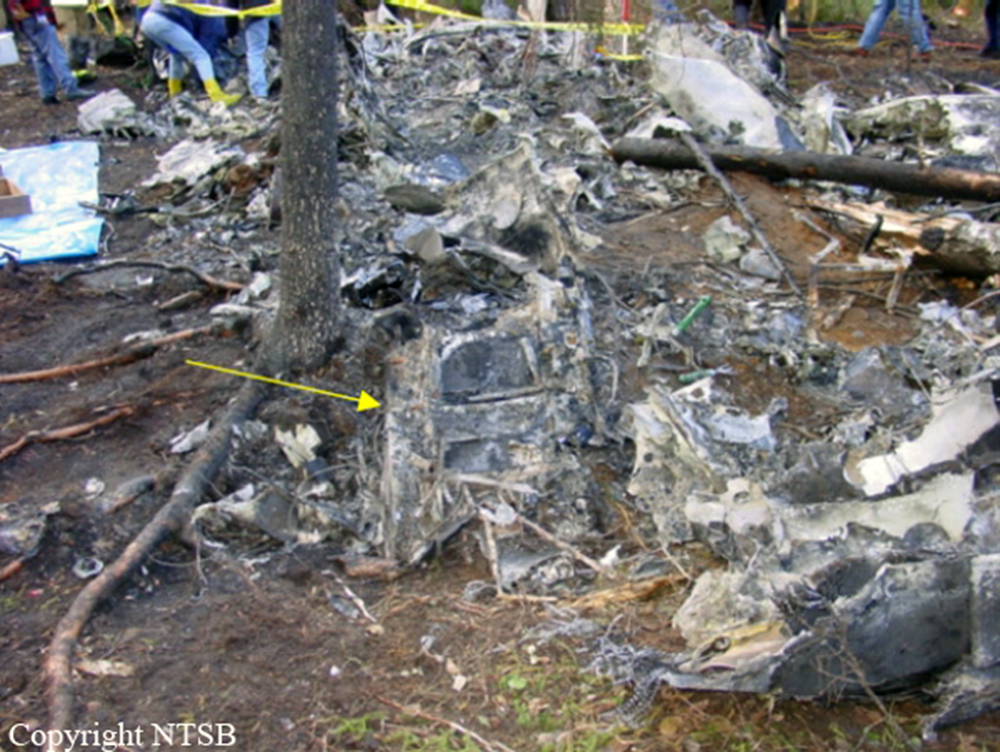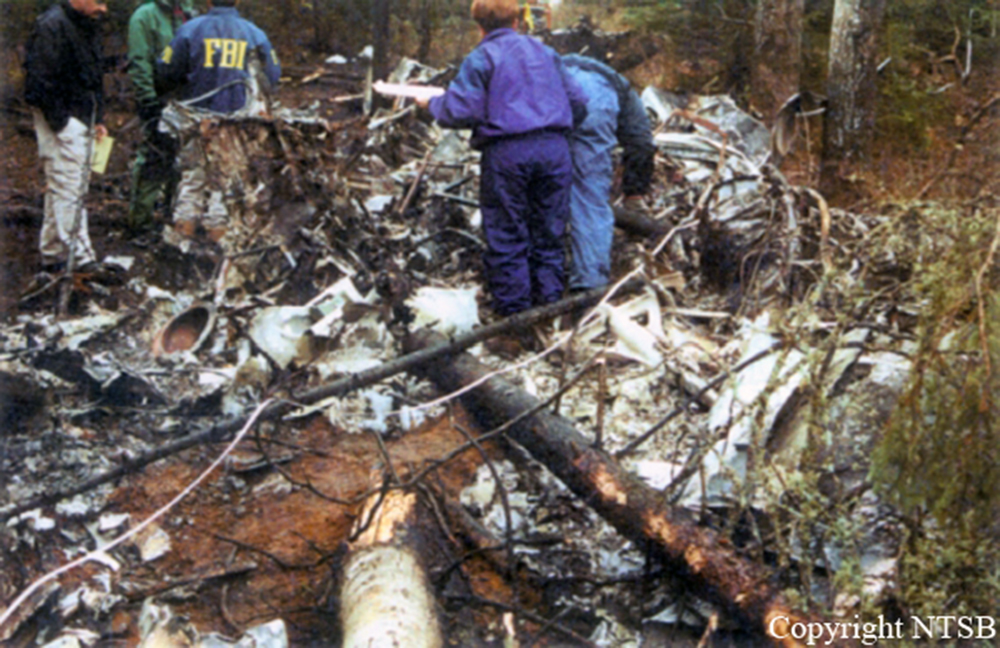Country
code
MN
Crash of a Beechcraft A100 King Air in Eveleth: 8 killed
Date & Time:
Oct 25, 2002 at 1022 LT
Registration:
N41BE
Survivors:
No
Schedule:
Saint-Paul – Eveleth
MSN:
B-245
YOM:
1979
Flight number:
N41BE
Crew on board:
2
Crew fatalities:
Pax on board:
6
Pax fatalities:
Other fatalities:
Total fatalities:
8
Captain / Total hours on type:
200.00
Copilot / Total hours on type:
107
Aircraft flight hours:
12726
Circumstances:
On October 25, 2002, about 1022 central daylight time, a Raytheon (Beechcraft) King Air A100, N41BE, operated by Aviation Charter, Inc., crashed while the flight crew was attempting to execute the VOR approach to runway 27 at Eveleth-Virginia Municipal Airport, Eveleth, Minnesota. The crash site was located about 1.8 nautical miles southeast of the approach end of runway 27. The two pilots and six passengers were killed, and the airplane was destroyed by impact forces and a post crash fire. The airplane was being operated under the provisions of 14 Code of Federal Regulations Part 135 as an on-demand passenger charter flight. Instrument meteorological conditions prevailed for the flight, which operated on an instrument flight rules flight plan. Among those on board were Paul Wellstone, Senator of Minnesota, his wife Sheila and one of his three children Marcia.
Probable cause:
The flight crew's failure to maintain adequate airspeed, which led to an aerodynamic stall from which they did not recover.
Final Report:




Crash of a Beechcraft 65-B80 Queen Air in Brainerd
Date & Time:
Oct 17, 1998 at 0033 LT
Registration:
N138BA
Survivors:
Yes
Schedule:
Minneapolis - Brainerd
MSN:
LD-361
YOM:
1967
Crew on board:
1
Crew fatalities:
Pax on board:
0
Pax fatalities:
Other fatalities:
Total fatalities:
0
Captain / Total hours on type:
1813.00
Aircraft flight hours:
8119
Circumstances:
The pilot said that during the ILS approach he reached a point where he thought he should be seeing the approach lights. He said that he checked the radio to determine if it was on the correct frequency. He said that he realized that the transmit switch was selected to the wrong radio and when he returned his attention to the instruments, he realized that he had allowed the airplane to descend low on the glide path. He said that before he could react, the airplane impacted the terrain.
Probable cause:
The pilot's failure to maintain the proper glidepath and his diversion of attention during a critical phase of flight.
Final Report:
Crash of a Cessna 421A Golden Eagle I in Little Falls: 1 killed
Date & Time:
Jun 1, 1998 at 1831 LT
Registration:
N541N
Survivors:
No
Schedule:
Little Falls - Little Falls
MSN:
421A-0161
YOM:
1968
Crew on board:
1
Crew fatalities:
Pax on board:
0
Pax fatalities:
Other fatalities:
Total fatalities:
1
Captain / Total hours on type:
1500.00
Circumstances:
A witness reported the airplane did not climb above 200 feet and reported seeing the airplane 'wobbling up and down' as it attempted to climb. He reported the airplane went into a sharp left bank and nose dived down. The airplane burned upon impact. The wreckage was located in a wooded area about 3/4 mile from the approach end of runway 30. Numerous open farm fields were located near the airplane's flight path. The winds were reported at 240 degrees at 22 knots gusting to 29 knots. The wreckage path was on a 040 heading and covered about 190 feet from initial tree impact to the location of the main wreckage. The engine inspection did not reveal any anomalies to either engine. The flight was the first maintenance check flight after the airplane had not been flown for 14 months. During maintenance the pilot had put about 100 gallons of water in the left main and left auxiliary fuel tanks to locate a fuel leak. A plug was installed in the left auxiliary fuel drain valve and the fuel tank could not be checked during preflight for fuel contamination without removing the plug.
Probable cause:
The pilot's continued operation with a known deficiency in equipment.
Final Report:
Crash of a Beechcraft E18S in Lake Elmo
Date & Time:
Oct 2, 1997 at 0605 LT
Registration:
N916TM
Survivors:
Yes
Schedule:
Lake Elmo - Minneapolis
MSN:
BA-337
YOM:
1958
Crew on board:
1
Crew fatalities:
Pax on board:
1
Pax fatalities:
Other fatalities:
Total fatalities:
0
Captain / Total hours on type:
350.00
Aircraft flight hours:
10530
Circumstances:
The pilot reported that the airplane lifted off at 70 knots. After accelerating in ground effect the airplane became 'unstable in the roll axis' so he added power. He reported that the left wing tip contacted the runway approximately 3/4 the way down the runway. The pilot then added additional power at which point the left wing contacted the grass off the left side of the departure end of the runway. The pilot then reduced the power to idle and landed the airplane in the grass collapsing the landing gear. The pilot reported that the engines sounded normal throughout the accident sequence. Investigation revealed another Beech 18 had taken off on the same runway, but in the opposite direction of N916TM less than one minute prior to the accident.
Probable cause:
The pilot's failure identify the unsafe condition (vortex turbulence) which existed due to departing airplane and his subsequent inability to control the airplane once encountering the turbulence.
Final Report:

Crash of a Cessna 401 in Crystal
Date & Time:
Jan 22, 1997 at 1326 LT
Registration:
N5AS
Survivors:
Yes
Schedule:
Crystal – Lansing
MSN:
401-0208
YOM:
1969
Crew on board:
2
Crew fatalities:
Pax on board:
1
Pax fatalities:
Other fatalities:
Total fatalities:
0
Captain / Total hours on type:
409.00
Circumstances:
After landing at the airport, the airplane was taxied to a fixed base operator to pick up a passenger. Rime ice, as thick as two inches was seen on the airplane, and the pilots of the airplane attempted to manually remove the ice. The airplane was topped off with fuel before departure. During departure from runway 31R, the airplane collided with a fence. Numerous areas of ice were found on the airplane following the accident. Both propellers had similar damage. The pilots had reported to the FAA that the left engine had sustained a loss of power. The passenger reported that he did not notice any loss of power from either engine. No preimpact part failure or malfunction of the left engine was found.
Probable cause:
Failure of the pilot-in-command to ensure adequate removal of airframe ice from the aircraft during preflight.
Final Report:


